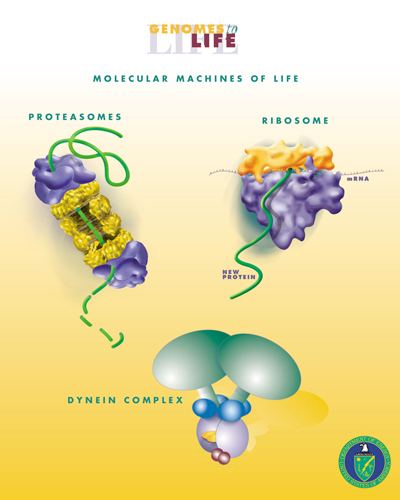 | ||
A molecular machine, or nanomachine, refers to any discrete number of molecular components that produce quasi-mechanical movements (output) in response to specific stimuli (input). The expression is often more generally applied to molecules that simply mimic functions that occur at the macroscopic level. The term is also common in nanotechnology where a number of highly complex molecular machines have been proposed that are aimed at the goal of constructing a molecular assembler. Molecular machines can be divided into two broad categories; synthetic and biological.
Contents
The 2016 Nobel Prize in Chemistry was awarded to Jean-Pierre Sauvage, Sir J. Fraser Stoddart and Bernard L. Feringa for the design and synthesis of molecular machines.
Examples
From a synthetic perspective, there are two important types of molecular machines: molecular switches (or shuttles) and molecular motors. The major difference between the two systems is that a switch influences a system as a function of state, whereas a motor influences a system as a function of trajectory. A switch (or shuttle) may appear to undergo translational motion, but returning a switch to its original position undoes any mechanical effect and liberates energy to the system. Furthermore, switches cannot use chemical energy to repetitively and progressively drive a system away from equilibrium whereas a motor can.
Synthetic
A wide variety of rather simple molecular machines have been synthesized by chemists. They can consist of a single molecule; however, they are often constructed for mechanically-interlocked molecular architectures, such as rotaxanes and catenanes. Carbon nanotube nanomotors have also been produced.
Biological
The most complex molecular machines are proteins found within cells. These include motor proteins, such as myosin, which is responsible for muscle contraction, kinesin, which moves cargo inside cells away from the nucleus along microtubules, and dynein, which produces the axonemal beating of motile cilia and flagella. These proteins and their nanoscale dynamics are far more complex than any molecular machines that have yet been artificially constructed.
Probably the most significant biological machine known is the ribosome. Other important examples include motile cilia. A high-level-abstraction summary is that, "[i]n effect, the [motile cilium] is a nanomachine composed of perhaps over 600 proteins in molecular complexes, many of which also function independently as nanomachines." Flexible linker domains allow the connecting protein domains to recruit their binding partners and induce long-range allostery via protein domain dynamics.
This protein flexibility allows the construction of biological machines. The first useful applications of these biological machines might be in nanomedicine. For example, they could be used to identify and destroy cancer cells. Molecular nanotechnology is a speculative subfield of nanotechnology regarding the possibility of engineering molecular assemblers, biological machines which could re-order matter at a molecular or atomic scale. Nanomedicine would make use of these nanorobots, introduced into the body, to repair or detect damages and infections. Molecular nanotechnology is highly theoretical, seeking to anticipate what inventions nanotechnology might yield and to propose an agenda for future inquiry. The proposed elements of molecular nanotechnology, such as molecular assemblers and nanorobots are far beyond current capabilities.
Research
The construction of more complex molecular machines is an active area of theoretical research. A number of molecules, such as molecular propellers, have been designed, although experimental studies of these molecules are inhibited by the lack of methods to construct these molecules. In this context, theoretical modeling can be extremely useful to understand the self-assembly/disassembly processes of rotaxanes, important for the construction of light-powered molecular machines. This molecular-level knowledge may foster the realization of ever more complex, versatile, and effective molecular machines for the areas of nanotechnology, including molecular assemblers..
